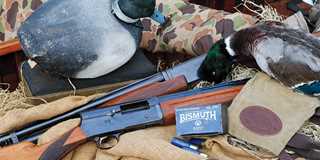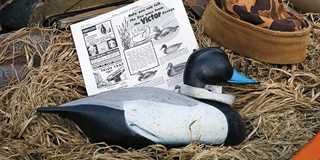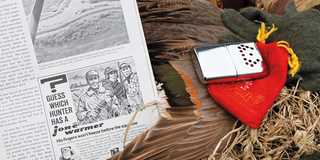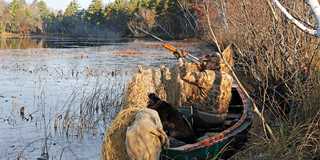Blasts from the Past
A season spent hunting with vintage gear brings back treasured memories from the author's youth
A season spent hunting with vintage gear brings back treasured memories from the author's youth

Story and Photos by Michael Furtman
When the Model 12 spoke, the mallards fell silent. Two, anyway.
Most squalled their way up through the falling snow, hightailing it downwind. The first drake had dropped to a snap shot just as it cleared the cattails in the curve of the creek. The second one, thankfully, was late to rise, and I took him after finally remembering to shuck the empty shell and pump a new load into the chamber. That happens when you're using a pump gun after shooting semiautos for decades.
On command, Bella piled over the bow of my father's 1946 Old Town square-ender and made short work of the retrieves, splashing down the sandy, shallow stream to where the birds had fallen. The happy old dog brought the drakes to the happy old hunter with her usual tail-high flair.
I hadn't planned to jump-shoot the creek that morning. That was plan B. Plan A was laid the evening before, when I had watched a cold front bring waves of diving ducks into the area. By dark, over a thousand bluebills, ringers, and redheads were resting on the lake. I would sneak out before first light, silently set up, and then fall upon them like a heron on a frog.
You know what they say about the best-laid plans of mice and men. Well before dawn, opting to row from shore so that the outboard wouldn't rouse the divers, I quietly put out my blocks. With the first light of dawn, I realized that I had worked up a sweat for no good reason. As far as I could tell, there wasn't a duck remaining on the lake. They had left in the night.
Ah, but not all of them! Far down the shore where a small stream enters the lake, a few groups of mallards were working. The ducks hardly circled before dropping from view behind snow-covered pines. Wherever they were going, they had been there before. Locals, no doubt.
That's when I conjured up plan B.
Once Bella handed off the second mallard to me, I turned the boat around and poled back up the stream. As I did, I grinned at how wise my father's choice had been. This boat was nearly perfect for hunting ducks on small- to medium-sized bodies of water, as it could be paddled, rowed, or driven by a motor. The pointed canoe bow helps ease it into or through vegetation. Hollow air chambers called sponsons run the length of the boat below the gunwales, making it virtually tip-proof. With the motor up, it drafts a mere couple of inches of water. It was both a plan A and a plan B boat, without which I would have very likely been duckless on this morning.
This hunt was one chapter in my season dedicated to the history of waterfowling. I had been contemplating a "retro" hunt for several years. What would it be like, I wondered, to hunt with the gear that was available decades ago? Would the old decoys and calls fool today's ducks? Would I stay warm and dry without the benefits of Thinsulate, Gore-Tex, and neoprene? Would I be able to hit anything with an antique full-choke Model 12? What memories might this vintage gear inspire? I decided it was time to find out, so I went about collecting as much hunting gear as I could from the days of my youth.
Some things, I suppose, can be tossed out without remorse. But not my father's boat. Nor his outboard. A man of simple means and tastes, Ralph made wise purchases, kept his gear well maintained, and fixed it when it broke. My dad had given me his cherished boat and motor knowing that I would not only care for them but also use them. Truth be told, during the many years he had been gone, they had mostly languished in my brother's barn, used only on occasion. I restored the cedar-plank-and-rib, canvas-covered Old Town and refurbished the Super Silent Six outboard. All I needed was sandpaper, varnish, and paint for the boat, plus a few replacement parts, a slotted screwdriver, and a wrench for the motor-simple gear, simple tools, simpler times.
With the boat looking splendid and the old Mercury running like new, it was time to gather the rest of the gear. Of course, a duck hunter needs decoys. Old as I am, I actually had a stash of cork decoys that I'd purchased many years ago, and thanks to the Internet, I was able to acquire other vintage corks, as well as early Herter's foam decoys. Clearing away debris in a friend's boathouse, I found a dozen 1960s Victor bluebill decoys made of tenite, an early plastic. Some needed caulk on their cracked keels, but they were otherwise serviceable. Finally, I rounded out my spread with some vintage-style burlap-wrapped decoys from Fowl Foolers and Autumn Wings Decoys. I used thick tarred cords for decoy lines, which I found to be superior to today's thin nylon ones for ease of handling. Decoy bags? Burlap sacks, just like Dad used, acquired free of charge at a local coffee grinder's loading dock.

Photo © MICHAELFURTMAN.COM
Some old decoys had keels for line winding, and the cross-shaped keels on the Victors were superb, taking up line much faster than the single keels on today's decoys. Using those without keels required me to remember the old X wrap-over the body, under the tail, over the body, and around the neck.
While today's decoys are superb, I have to say the ducks tolled just as eagerly to these old-school blocks. A full spread of these vintage dekes looked damn fine, and I enjoyed the resounding thunk they made on the water when I tossed them out. On windy days, the corks rode the chop better than any decoys I've used in years, and I suspect they'll remain in my spread in the future, especially for use along the edges.
I didn't often see wigeon on this northern Wisconsin lake. In the 40 or so years that I've hunted it, I think I've bagged two. So I was surprised one morning when I heard a drake's distinctive whistle. I peered from beneath my cap's brim, trying not to show my face, until I spotted the flock of eight ducks, angling steeply toward the decoys the way wigeon do.
I kept my head down, but Bella's eyes told me the ducks were out front. Rising and swinging, I picked a white-capped drake, and with the second shot from my Browning A-5, he tumbled to the water.
I hunted all season with the A-5, which I bought used in 1978, and my father's Winchester Model 12 with a 30-inch full-choke barrel, which he bought used in 1945. Both are chambered for only 2 3/4-inch shells. While I had a Japanese-made barrel for the old A-5, which would have allowed the use of steel shot, I opted for the original 28-inch modified-choke Belgian barrel. Since Dad's gun couldn't handle steel, I figured I'd avoid confusion and shoot the same loads in both. Thankfully Kent makes excellent bismuth ammo that proved to be deadly.
I'd forgotten until I was oiling up these venerable duck guns that both were designed by John Browning, although only the A-5 carried his name. He licensed the Model 12 design-often called the "perfect repeater"-to Winchester. Both were favorites of waterfowlers for most of the last century, and many are still in use today.
In the field, these guns were a joy to shoot. The old humpbacked A-5 that dropped the wigeon swings as smoothly as Hank Aaron's bat; the Model 12 that spoke to the mallards points like a setter. Today's shotguns are lighter, and yes, they come camouflaged, but blued steel and oiled walnut are more pleasing to the eye and the touch, and in a duck blind or boat, an extra pound of weight isn't a big deal. I grew up shooting a 16-gauge Model 12, so shucking shells was not a foreign experience, but I must admit that I did forget to pump the action a few times after years of using autoloaders. The cha-chink of that slide, though, was music to my ears-a sweet sound from my youth.
A search for gun cases of the era, which consisted of simple canvas sleeves, was a miserable failure, so I took the guns to Frost River in my hometown of Duluth, Minnesota. They manufacture packs and luggage from waxed canvas and readily agreed to make replica sleeves for me. Waterproof, lightweight, and easy to stow in the blind, they protected the guns admirably through rain and snow.
Now I just needed a case for my ammo. Blind bags were unheard of back then, and most hunters used surplus military shell boxes for ammo storage. But in the boathouse, where the Victor decoys had lived under mouse nests for 60 years, I found not one, but two shell boxes with revolving seats made by Queen Stove Works of Albert Lea, Minnesota. Not only did they provide dry storage for shells and sandwiches, I decided that the padded lid, which rotates for swinging on birds, was as brilliant as it was functional.
My Yentzen duck call was already vintage, but I swapped the fancy lanyard for a simple leather string. Heck, I even put a leather collar on Bella, and replaced the nylon boat lines with sisal rope. My rusty Stanley thermos was sufficiently old-school, and after searching online I purchased a classic Jon-e handwarmer, which produces heat by burning lighter fluid. Except for modern PFDs in the boat, I was about as authentic as I could get.

Photo © MICHAELFURTMAN.COM

Photo © MICHAELFURTMAN.COM

Photo © MICHAELFURTMAN.COM
There was a tinkling of skim ice along the shoreline as I launched the Old Town before dawn. While the morning would be sunny and calm, I hoped the stands of wild rice on this central Minnesota lake would draw ducks despite the bluebird weather. Two tugs and the Mercury sprung to life, the old boat splintering the thin ice to open water.
Wild rice and outboard motors don't go well together. Rice stalks are tough and will wind into a rope around the prop in no time. After running the open part of the lake, I tipped the motor up, moved to the rowing seat, and pulled on the oars. It was a surprisingly good feeling.
In the rice, I tossed the blocks hither and yon, puddlers to the right, divers to the left, with a hole in the middle of the spread in front of a small point of floating bog. With Dad's boat poled as far into the point's vegetation as possible, I set up a boat blind of thin boards slipped into the slotted gunwales with woven grass netting strung between them. Bella sat erect. We were ready.
Clothing for this day, and of that earlier era, was simple and effective: a tan canvas jacket, down vest, wool gloves, wool shirt, canvas pants with wool long johns underneath, and waxed cotton cap. Most of these garments can still be purchased today, though today's wool is superior to that of yesteryear in that it is machine washable and not the least bit itchy. During the course of the season, I found it superior not only to the old wool but also to any modern synthetic.
If waders were available in the 1960s, when I started hunting, they were rare. All the old-timers who taught me to hunt wore hip boots, and LaCrosse still makes the green insulated hippers I remembered. It had been years since I had worn hip boots, but after a fall of using them again, I wondered why. Yes, chest waders are better in many instances, but hip boots offer a lot more freedom of movement when climbing in and out of boats and jump-shooting on creeks. Except for the occasional soggy butt from sitting on something wet (I now know why the hunting pants of that era had a rubber liner in the seat), I truly enjoyed using them.
At the beginning of the autumn, none of the clothing I wore was camouflaged, and I don't feel that it was a hindrance. Subtle earth tones blended well enough, and as experienced duck hunters know, it's movement that will give you away nine times out of 10. But there was one thing I did miss about today's clothing: waterproofing.
Don't get me wrong, waxed cotton does a good job, and in light rain or snow it works fine. But we hunted on days when wet, sloppy snow was driven by strong winds, which eventually froze the canvas into armor plating. It was hard to move, let alone shoot. I guess those old-timers were tougher than I am. Once the really "fowl" weather came, I jumped forward a decade or so in outerwear.
Before Orvis introduced the first brown camouflage duck hunting clothing in 1971, the only camo available-if you had any at all-was military surplus and made only in green, which was ill-suited for many duck hunting situations. Sometime in the late 1970s, I acquired my first camo duck parka from Columbia Sportswear, which I wore until it was rags. In my closet, though, I found another old coat, a 1980s Bob Allen parka with what may have been the first Ducks Unlimited camouflage pattern. I pressed this old parka into service as the weather worsened, wearing it over layers of wool and goose down along with my Redhead camo hat from the same era. During the bitter-cold final weeks of the season, I was warm and dry.
Not that I needed to worry about getting wet or cold on this particular day. The forecast had proved accurate. It was warm, at least for October, and few ducks were moving, except for one large flock of ringnecks, which ripped overhead with a distant destination in mind. I reacted quickly enough to drop one drake as the wedge whistled past, and Bella happily did her thing. Then I rowed out to pick up the dekes.
A lot of work for one duck. A lot of fun too. Messing around with old gear is a great way to spend any fall day.

Photo © MICHAELFURTMAN.COM
It turns out that those two drake mallards I dropped in the creek were the last of the season. While a few more days remained, they proved brutally cold. All but the largest lakes froze, and even those were iced over near the boat landings. I was done.
I wish I could say that I piled up ducks like they did in the old days. I did not. But I bagged enough to keep the dog and myself happy, and to size up the effectiveness of the old equipment. The verdict? The old gear rocked. Yes, you have to oil that blued steel. Yes, the decoys were heavier. Sure, you're going to have to cough up a few extra bucks for bismuth or tungsten-polymer ammo to occasionally shoot Dad's or Granddad's gun. Small prices to pay, in my estimation. The Yentzen talks duck as well as most real mallards. The odor of the Jon-e soon becomes comforting, as does the heat on your hands. The old blocks and today's burlap-wrapped decoys fooled ducks and spawned pride. And wool and down can't be beat for warmth and comfort. Then there was my dad's boat and motor-elegant, functional, and durable.
Old memories flowed like the creeks I hunted. At times, I was a boy again, my dad and I heading out into vast Lake Winnibigoshish to hunt the diving ducks he loved. Instead of Bella in the bow, there sat Kim, my father's favorite black Labrador. Once, I swear that I saw Gypsy, the Lab of my college years, swim past my old cork decoys with a bluebill in her mouth. Cleaning ducks and gear in the evening, I was joined once more by Reuben and Jeff, my dad's duck hunting partners, joshing me about my first schoolboy crush or missed shots as we plucked ducks, Reuben's cigar occasionally igniting free-floating down. I even recalled the long-forgotten memory of how my brother and I, while sitting in this same boat, were stunned as the only mallard that we had bagged that day rose from the dead, hopped up onto the bow, and then flew away.
I suspect the same will happen for you, even if your "good old days" were the 1990s and not the 1960s. Dig out some old gear. Fix it up. Incorporate bits of it into your hunts. You don't have to go whole hog like I did. The sense of satisfaction that comes from including even one special decoy, or wearing Dad's old coat, won't be surprising. We all know that hunting is about much more than shooting ducks.
Yes, I have had more productive autumns. But never a more enjoyable one.
Ducks Unlimited uses cookies to enhance your browsing experience, optimize site functionality, analyze traffic, and deliver personalized advertising through third parties. By continuing to use this site, you agree to our use of cookies. View Privacy Policy